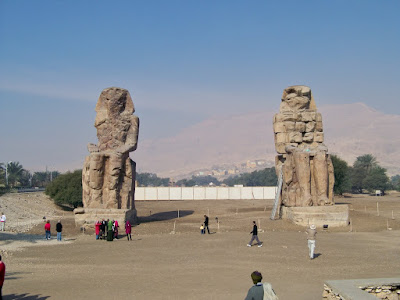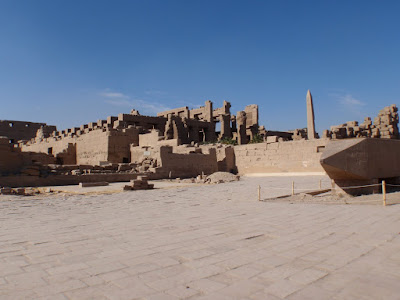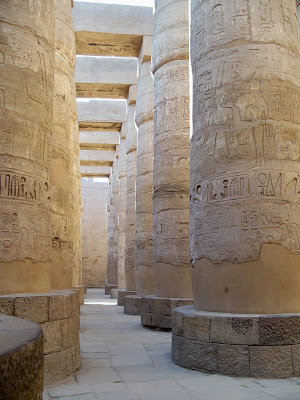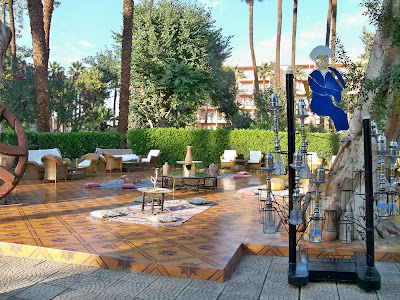Another super early start, Dalia wants us to get to the Valley of the Kings when it opens.
 Sorry this is blurry, this street looked so pretty with all the little lights,
Sorry this is blurry, this street looked so pretty with all the little lights, we crossed over to the left bank of the Nile by boat to get there faster, we had the most festive boat,
we crossed over to the left bank of the Nile by boat to get there faster, we had the most festive boat, Ancient Egyptians believed that to speak the name of the dead made him live again. The tombs were inscribed with the names, and titles and held images and statues of the kings. Beginning in the New Kingdom with the 18th dynasty the pharaohs abandoned Memphis and Saqqara and built their tomb in Thebes for about 500 years. They no longer built pyramid style tombs. The tombs were cut into the limestone following a similar pattern: three corridors, an antechamber, and a sunken sarcophagus chamber. Construction lasted about 6 years. Valley of the Kings is located in the Theban Hills, at the every end is the pyramid shaped peak of al-Qurn.
Ancient Egyptians believed that to speak the name of the dead made him live again. The tombs were inscribed with the names, and titles and held images and statues of the kings. Beginning in the New Kingdom with the 18th dynasty the pharaohs abandoned Memphis and Saqqara and built their tomb in Thebes for about 500 years. They no longer built pyramid style tombs. The tombs were cut into the limestone following a similar pattern: three corridors, an antechamber, and a sunken sarcophagus chamber. Construction lasted about 6 years. Valley of the Kings is located in the Theban Hills, at the every end is the pyramid shaped peak of al-Qurn. This was taken in the parking lot, no cameras are allowed beyond here. The tombs we went in was spectacular with brilliant colors telling the stories of the pharaohs and gods like the walls and ceiling. It was so smart to be the first there, we had the tombs pretty much to ourselves, after that there were huge long lines going in and out of the tombs.
This was taken in the parking lot, no cameras are allowed beyond here. The tombs we went in was spectacular with brilliant colors telling the stories of the pharaohs and gods like the walls and ceiling. It was so smart to be the first there, we had the tombs pretty much to ourselves, after that there were huge long lines going in and out of the tombs. Howard Carter's house. He was an archaeologist and Egyptologist and noted as the discoverer of the tomb of Tutankhamun on November 4, 1922.
Howard Carter's house. He was an archaeologist and Egyptologist and noted as the discoverer of the tomb of Tutankhamun on November 4, 1922. This is the Valley of the Nobles, also on the west bank of Luxor in an area called Sheik Abd El-Korna. It contains the rock cut tombs of Nobles and high officials who served the pharaohs during the New Kingdom (1500-500 bc).
This is the Valley of the Nobles, also on the west bank of Luxor in an area called Sheik Abd El-Korna. It contains the rock cut tombs of Nobles and high officials who served the pharaohs during the New Kingdom (1500-500 bc). Taking a balloon ride out over the area is a popular way to spend the day,
Taking a balloon ride out over the area is a popular way to spend the day, Hatshepsut (pronounced Hat-sheep-suit) means Foremost of the Noble Ladies, was the 5th pharaoh of the 18th dynasty and reigned 22 years. She is considered one of the most successful pharaohs. She was one of the most prolific builder in ancient Egypt construction 100's of structures in Upper and Lower Egypt We are heading for Djeser-Djeseru, Hatshepsut's mortuary temple complex at Deir el-Bahri. What is called the Luxor Massacre took place here in 1997, 58 tourists and 4 Egyptians were massacred by Islamist terrorists from Al-Gama'a al-Islamiyya.
Hatshepsut (pronounced Hat-sheep-suit) means Foremost of the Noble Ladies, was the 5th pharaoh of the 18th dynasty and reigned 22 years. She is considered one of the most successful pharaohs. She was one of the most prolific builder in ancient Egypt construction 100's of structures in Upper and Lower Egypt We are heading for Djeser-Djeseru, Hatshepsut's mortuary temple complex at Deir el-Bahri. What is called the Luxor Massacre took place here in 1997, 58 tourists and 4 Egyptians were massacred by Islamist terrorists from Al-Gama'a al-Islamiyya. Deir el-Bahari means "The Northern Monastery" and is a complex of temple and tombs on the west bank of the Nile opposite Luxor.
Deir el-Bahari means "The Northern Monastery" and is a complex of temple and tombs on the west bank of the Nile opposite Luxor. the mortuary temple of Hatshepsut, Djeser-Djeseru meaning "Splendor of Splendors" was built to worship her after she died and to honor the glory of Amun. There was once beautiful gardens on the terraces and surrounding the long ramps,
the mortuary temple of Hatshepsut, Djeser-Djeseru meaning "Splendor of Splendors" was built to worship her after she died and to honor the glory of Amun. There was once beautiful gardens on the terraces and surrounding the long ramps,
 Queen Ahmose is shown pregnant being led to the birthing room by the gods, Heket and Khnum,
Queen Ahmose is shown pregnant being led to the birthing room by the gods, Heket and Khnum,




 the chapel of Anubis,
the chapel of Anubis,
 Thutmosis III gives wine to Sokaris, the Anubis Chapel,
Thutmosis III gives wine to Sokaris, the Anubis Chapel,
 there once was a long avenue of sphinxes,
there once was a long avenue of sphinxes,
 in a festival scene, soldiers run forward carrying branches and their axes, above it ships are shown with the baskets carrying the trees, soldiers and many other items,
in a festival scene, soldiers run forward carrying branches and their axes, above it ships are shown with the baskets carrying the trees, soldiers and many other items, Temple of Mentouhotep II of the 11th dynasty was the first monument built here,
Temple of Mentouhotep II of the 11th dynasty was the first monument built here,
 Tuthmosis III's temple, in the distance is the tomb of Montuemhat along with hundreds of other tombs,
Tuthmosis III's temple, in the distance is the tomb of Montuemhat along with hundreds of other tombs, tree of life,
tree of life, Hatshepsut stood at each pillar, the lower body is shrouded, and is holding a crook and flail associated with Osiris,
Hatshepsut stood at each pillar, the lower body is shrouded, and is holding a crook and flail associated with Osiris,


 sanctuary doors,
sanctuary doors,
 beautiful gardens once filled this area,
beautiful gardens once filled this area, three layers of terraces,
three layers of terraces, Hatshepsut sent out five ships to the Land of Punt, they returned with 31 live myrrh trees with roots carefully kept in baskets. Depictions of this are on the walls of her temple. This is possibly the stump of one such tree.
Hatshepsut sent out five ships to the Land of Punt, they returned with 31 live myrrh trees with roots carefully kept in baskets. Depictions of this are on the walls of her temple. This is possibly the stump of one such tree.
 Tomb of Montuemhat,
Tomb of Montuemhat, Alabaster of the ancient Egyptians and the bible is termed Oriental alabaster, was esteemed for making perfume bottles, jars and various sacred objects as well as large sarcophagus and sphinxes.
Alabaster of the ancient Egyptians and the bible is termed Oriental alabaster, was esteemed for making perfume bottles, jars and various sacred objects as well as large sarcophagus and sphinxes.  the man are hand working alabaster which produces the finest pieces,
the man are hand working alabaster which produces the finest pieces, tools used to make the bowl shape as well as chunks of the mineral,
tools used to make the bowl shape as well as chunks of the mineral, thicker, heavier pieces are made by machine,
thicker, heavier pieces are made by machine, the purest alabaster is snow white, it's softness enables it to be carved but it is soluble in water, if smooth alabaster is washed it will become rough and dull loosing its translucency and luster, here we are being shown how beautiful it looks with light in it,
the purest alabaster is snow white, it's softness enables it to be carved but it is soluble in water, if smooth alabaster is washed it will become rough and dull loosing its translucency and luster, here we are being shown how beautiful it looks with light in it, next we pass by the Ramesseum, the mortuary temple of pharaoh Ramesses II,
next we pass by the Ramesseum, the mortuary temple of pharaoh Ramesses II,
 statue and excavations of Amenhotep III,
statue and excavations of Amenhotep III,

 the Ramesseum in the distance,
the Ramesseum in the distance, Valley of the Nobles and the Valley of the Queens,
Valley of the Nobles and the Valley of the Queens, Colossi of Memnon, two massive stone statues of pharaoh Amenhotep III which have stood since since 1350 bc, on the side panel shows two images of the god Hapi and to the the right standing knee high is his wife Tiy,
Colossi of Memnon, two massive stone statues of pharaoh Amenhotep III which have stood since since 1350 bc, on the side panel shows two images of the god Hapi and to the the right standing knee high is his wife Tiy, this whole area here, still under excavation is referred to as the Memnonium,
this whole area here, still under excavation is referred to as the Memnonium, Thebes across the river,
Thebes across the river, the Winter Palace Hotel,
the Winter Palace Hotel, this is the Karnak Temple Complex, the largest temple complex ever built is comprised of a vast mix of ruined temples, chapels, pylons, and other buildings, as well as the Sacred Lake, its ancient name was Ipet-isut meaning "The Most Sacred of Places,"
this is the Karnak Temple Complex, the largest temple complex ever built is comprised of a vast mix of ruined temples, chapels, pylons, and other buildings, as well as the Sacred Lake, its ancient name was Ipet-isut meaning "The Most Sacred of Places," ram statues leading toward the Nile,
ram statues leading toward the Nile, construction of the temples began in the Middle Kingdom and continued through to Ptolemaic times, 30 pharaohs contributed to the building, there is a range of gods dedicated at Karnak, each god area is known as a precinct,
construction of the temples began in the Middle Kingdom and continued through to Ptolemaic times, 30 pharaohs contributed to the building, there is a range of gods dedicated at Karnak, each god area is known as a precinct,




 the Precinct of Amun-Re is the chief deity in the Theban Triad, also Hypostyle Hall,
the Precinct of Amun-Re is the chief deity in the Theban Triad, also Hypostyle Hall, ram headed sphinx,
ram headed sphinx,













 the temple of Amon-Ra,
the temple of Amon-Ra,


 south gate pylons,
south gate pylons,

 the sacred lake, the structure is the Sanctuary of Montu-god of war and sport,
the sacred lake, the structure is the Sanctuary of Montu-god of war and sport, the pylon of Thutmose III, this area is scattered with fallen blocks,
the pylon of Thutmose III, this area is scattered with fallen blocks,
 the Temple of the Theban moon god Khonsu, son of Amun and Mut
the Temple of the Theban moon god Khonsu, son of Amun and Mut map,
map,
 court yard of the 7th pylon,
court yard of the 7th pylon, the most impressive part of Karnak is the Hypostyle Hall in the Precinct of Amun-Re, a hall of 50 sq ft with 134 massive columns arranged in 16 rows,
the most impressive part of Karnak is the Hypostyle Hall in the Precinct of Amun-Re, a hall of 50 sq ft with 134 massive columns arranged in 16 rows,

 Hypostyle Hall had a roof and the only light entered through slits-shown above,
Hypostyle Hall had a roof and the only light entered through slits-shown above, behind the entrance or first pylon, part of the ramp is still here that was used to build it,
behind the entrance or first pylon, part of the ramp is still here that was used to build it,
 ram head sphinxes,
ram head sphinxes,
 the ram head sphinxes leading out the south entrance that went over to the Luxor Temple and met up with the human head sphinxes,
the ram head sphinxes leading out the south entrance that went over to the Luxor Temple and met up with the human head sphinxes, the human head sphinxes leading to the Luxor Temple,
the human head sphinxes leading to the Luxor Temple, driving past Luxor Temple,
driving past Luxor Temple,
 flowers at the Winter Palace,
flowers at the Winter Palace, playing in the pool,
playing in the pool, smoking area,
smoking area,


 alabaster lanterns,
alabaster lanterns,
Erica making a disk over her head pretending to be a goddess-I am so shocked how much she learned,
No comments:
Post a Comment